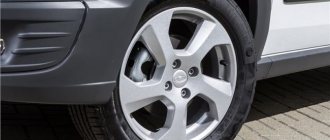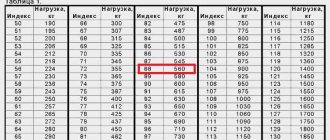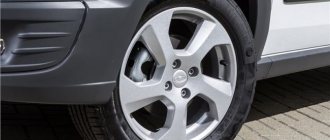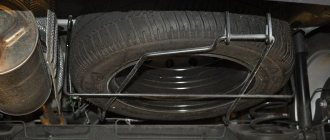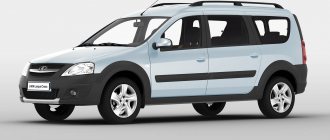Many do not see the need to pay attention to the differences between the classic model and the Cross version due to the slight difference. But there are still distinctive features. Perhaps, to automobile experts who constantly keep their finger on the pulse of events in the Russian automobile industry, the differences are obvious.
This review is not for specialists, but for ordinary consumers who, when purchasing one or another modification of Largus, will be interested in questions about the engine, dimensions, ground clearance or wheels of this car. And there are a considerable number of such potential buyers, because in addition to the fact that the classic family car has proven itself well for several years, the cross-country version attracts with its adaptability to Russian road conditions.
Also, some modified body features give the off-road station wagon a slightly different look. Thus, potential consumers become interested in what differences they will have to pay extra for. Therefore, it’s definitely worth comparing “colleagues” on the conveyor.
Appearance of Largus Cross on the Russian market
The crossover version was developed as a result of AvtoVAZ’s policy: improving cars and striving to meet the needs of all categories of drivers. Over the years, the standard Largus has established itself as a market leader among fans of quiet family driving.
In addition, Largus is available in the form of a van. This fact adds to the number of consumers of this model entrepreneurs, rural residents and everyone interested in transporting cargo. For this segment of buyers, a standard station wagon is suitable in almost all respects: a comfortable, roomy interior, the ability to accommodate from 5 to 7 passengers inside (depending on the purchased modification), low fuel consumption and discreet classic style.
But since, as mentioned above, among Lada consumers there are drivers who often drive outside the city on rough terrain, the question of creating an off-road version of Largus has become urgent. AvtoVAZ specialists revealed that the demand for the production of such a car is high, and it was decided to design a modified version of the station wagon, which is better adapted for off-road use. And, starting from 2015, a modified version of the station wagon is produced with the cross prefix.
Improved adaptation to poor road conditions was achieved by changing some technical parameters. There was also a slight modification to the external and internal appearance of the car.
Salon Lada Largus and Lada Largus Cross
The interior of the Largus Cross (right) looks more interesting due to additional stitching on the seats and gray plastic inserts on the center console.
Pleasant differences
During the measurements, it turned out that the ground clearance of the Cross version is as much as 210 mm (under the protection of the engine crankcase). For a car that, according to its creators, should regularly drive off the asphalt, this is not bad. For a regular Largus, the ground clearance was 182 mm under a similar engine compartment shield. By the way, the manufacturer states that when fully loaded, including passengers in the last, third row of seats, the ground clearance will be at least 170 and 145 mm, respectively.
Our Cross turned out to be 35 kg heavier than the usual Largus. But one plastic body kit, which adds brutality and protects the car’s paintwork from scratches when driving over rough terrain, cannot weigh that much. Some of this 35 kg can be attributed to larger wheels. Perhaps there will be other technical solutions that will give the model additional weight?
We drive the cars onto lifts, remove the wheels and conduct a thorough inspection. Despite the apparent identity, differences were still found. Largus with the Cross prefix has original front struts. In particular, the spring cup is welded to the body 30 mm higher than that of the station wagon. This also ensures increased ground clearance. By the way, both models are equipped with Monroe struts from the factory. The rear gas-filled shock absorbers are also different. This is confirmed by identification numbers. The housings and shock absorber rods of the Largus Cross are longer, and the length of the rear suspension springs is also increased.
Differences in technical characteristics
When it comes to a car related to the crossover segment, in most cases such a body is supported by all-wheel drive (when the structure of the transmission allows torque to be transmitted to all 4 wheels). Such modifications in the case of passenger cars are often called 4x4. As a result of the modification of the Lada, the 4x4 option was not added, since in this case the updated car would have cost much more. The car retained front-wheel drive also because to optimize the design, the B0 platform on which the car was created would have to be slightly changed.
The most significant changes to which the “off-road” version of the Lada was subjected are as follows.
| Aspects | Indicators |
| The difference between the ground clearances of the two models is noticeable in favor of the cross version. | The modernized model has ground clearance of 2.5 cm (when loaded - 1.75 cm). |
| Wheel rims have become 1 inch larger in diameter | 16 versus the previous 15. |
| The tire profile and brand have been changed. | The Cross version is equipped with 205 mm wide Continental tires with a 55% profile. |
| Of the two engines offered by the standard Largus, only one is available in the updated version | 105 hp. |
Ground clearance has been increased through two changes.
- First of all, the suspension was retuned. In the front part, struts of a different type are used, as well as modified shock absorbers. Plus, the rear suspension uses higher springs.
- An increase in ground clearance by half a centimeter was also achieved due to modifications to the wheels, but for the most part it was possible to raise the body due to modifications to the suspension.
The changed ground clearance does not give the new Largus the right to be called a crossover, but still makes driving on Russian off-road roads more comfortable.
If you compare the tires and wheels of two cars, you will notice not only an increase in the rim diameter and linear dimensions of the rubber, but also the use of exclusively Continental wheels. The modification also involves the use of slightly different strut supports and silent blocks (rubber connecting elements of the suspension). The crossover station wagon was presented to customers with modified steering and braking systems.
Today, VAZ produces Largus Cross with one engine option. This is a 1.6-liter gasoline power unit from Renault with 16 valves with a capacity of 102 horsepower (by the way, the passport of a regular Largus with a similar engine indicates the power limit indicated by 3 hp more).
The modified version differs from the standard station wagon only in one proposed engine. Let us remind you that the previous version of Largus has two engines in its arsenal: the aforementioned 105-horsepower unit and a domestic engine with 8 valves with a capacity of 87 horsepower. The second one was recently introduced by AvtoVAZ. Its predecessor is a French 84-horsepower eight-valve engine. In terms of the number of engines, the regular Largus is better.
The five-speed manual transmission installed in the standard Largus has not been changed.
Shock absorbers Lada Largus Cross
The cup for the spring on the front struts of the Largus with the Cross prefix (right) is welded 30 mm higher than that of the Largus station wagon (left).
As I was told at VAZ, when working with the suspension of the cross-version, the engineers were faced with the task of maintaining the suspension settings of the regular Largus as much as possible, and they succeeded. In terms of handling and level of driving comfort, the cars are very similar. At least, the average driver is unlikely to feel the difference in the behavior of the car on a good road. But when driving on a dirt road or broken asphalt, the Largus Cross slightly benefits in terms of smoothness due to the increased rolling radius of the wheel and wider tires.
Changes to the interior and exterior
Throughout production, production Lada Largus Cross cars are available in a single configuration, which includes all the options that make up the “luxury” kit of a regular station wagon, namely:
- availability of air conditioning;
- two pillows;
- ABS systems;
- leather steering wheel;
- heated front seats;
- electric mirror adjustment;
- window lifters.
The crossover also comes with a stereo system consisting of 4 speakers. There is a luggage rack on the interior headliner. The driver's seat is height adjustable, and a parking radar will help you park safely.
The Largus Cross salon is distinguished by stitching of the seat upholstery in the original orange color. Inserts on the instrument panel and doors are made in the same shade. Since 2015, a similar interior trim has been added with gray inserts instead of orange. This modification has been introduced for an older audience.
The comparison of the exterior should start with the bumper. The main distinguishing feature of the exterior is the enlarged front and rear bumpers painted black. In addition to fog lights, which are included in both the standard and Cross station wagons, the only Cross trim level is immediately equipped with roof rails. The rims on the wheels are not only larger in diameter, but they also have a stylish design.
Pronounced changes are also visible in profile. Due to the increased ground clearance and wheels, the body looks raised. The side arches and sills are made similarly in black.
If the image doesn’t bother you, you like the ground clearance, like a jeep, and in addition, you’ll admire the large capacity in the form of a 5/7-seater interior and a huge trunk, and “not expensive” - that’s all, we’ve arrived. Yes, not on anything, but on a raised Lada Largus with a talking Cross prefix and, of course, DNA from Renault Logan. This model, first presented to Russians in 2015, does not have many competitors. Of the serious ones, we can only remember the Lada Kalina Cross (in-brand cannibalism, as they say), and of the not very serious ones - the Renault Sandero Stepway, which seems small compared to the Lada station wagons, and the “Chinese” like the Lifan X50/X60 or the Geely MK Cross, whose reputation , alas, cannot boast of impeccability. Read all the details about the cross-version, which was begging to be released after the standard Largus with its modest ground clearance, in our review!
Shock absorbers Lada Largus Cross
The rear suspension design has different shock absorbers and springs.
Cross economics
It is unlikely that there will be conditions in which the geometric cross-country ability of vehicles will play a decisive role. Still, the difference in ground clearance is not so significant. More important, I think, are fuel consumption indicators. The “elevated” Largus spends 1.4 liters more for every hundred kilometers driven in the city and 0.8 liters more when driving on the highway compared to a station wagon without the Cross prefix. At least that's what the manufacturer says. But this is already a noticeable difference, especially over a long distance. What is it due to? Considering that the gear ratios of the cross-modification gearbox have not changed, we can only rely on aerodynamics, wheel size and an additional 35 kg of curb weight.
Specifications
| Characteristic | 1.6MT |
| Engine's type: | Petrol |
| Engine capacity: | 1598 |
| Power: | 106 hp |
| Acceleration to 100 km/h: | 13.1 s |
| Maximum speed: | 165 km/h |
| Consumption in the urban cycle: | 11.5/100km |
| Extra-urban consumption: | 9.5/100km |
| Combined cycle consumption: | 9.0/100km |
| Fuel tank capacity: | 50 l |
| Length: | 4470 mm |
| Width: | 1756 mm |
| Height: | 1682 mm |
| Wheelbase: | 2905 mm |
| Clearance: | 170 mm |
| Weight: | 1270 kg |
| Trunk volume: | 560 l |
| Transmission: | Mechanical |
| Drive unit: | Front |
| Front suspension: | Independent – McPherson |
| Rear suspension: | Semi-independent - torsion beam |
| Front brakes: | Disk |
| Rear brakes: | Drums |
| Production: | Tolyatti |
Dimensions Lada Largus cross 5 seats
- length - 4.470 m;
- width - 1.756 m;
- height - 1.682 m;
- wheelbase - 2.9 m;
- ground clearance - 170 mm;
- trunk volume - 560 l.
Interior differences
The changes also affected the interior of the Lada Largus Cross. The designers diluted the classic interior of the regular Largus with bold diamond-shaped stitching . The stitching uses orange threads to create a pattern of small and large diamond shapes. Compared to the interior of the seats in previous versions, the new solution looks modern and bright.
Salon "Lada Largus Cross"
A striking difference is the bold orange inserts in the door trim, front seats and center console. However, the emphasis is on contrast, it successfully harmonizes with the red elements of the car’s controls and does not stand out from the general style of the interior.
In addition to interior solutions, the cabin contains such useful functions as:
- Seat belts can be adjusted in height.
- Electric window lifts on all doors.
- Multifunctional audio system, with the ability to connect devices via Bluetooth and an AUX connector. This will allow you to talk on the phone without being distracted from driving. The system allows you to connect external drives via USB and play MP files
Difference in initial configurations and prices of Lada Largus and Lada Largus Cross cars
If the Lada Largus configuration began with an eight-valve 1.6-liter engine (87 l/s) , then the Lada Largus Cross is equipped with a sixteen-valve 1.6-liter (106 l/s) .
Test drive Lada Largus cross 5 seats - video
Advantages and disadvantages of Lada Largus cross 5 seats
You will like Largus Cross if you value:
The advantages include:
- affordable price;
- good maneuverability;
- spacious interior;
- spacious cargo compartment;
- unpretentiousness to the quality of gasoline;
- good equipment.
The disadvantages include:
- boring design;
- budget-friendly interior decoration;
- ergonomic shortcomings;
- mediocre dynamics;
- There is no heated steering wheel or windshield.
Lada Largus and Lada Largus Cross
Don’t think that by choosing Largus in the Cross version, you will become an off-road conqueror. But you will have access to slightly deeper ruts.
Summarize. If you want a little better ride and comfort, or if you need to regularly wade through fields and small bushes without damaging the body, take the Largus Cross. If every penny counts, a station wagon will do - it’s both cheaper and a little more economical to operate. By the way, Largus without the Cross prefix is also available with an eight-valve engine that can be fed with 92-octane gasoline. But the 102-horsepower sixteen-valve engine installed on the test cars is designed for 95-octane gasoline.
As for sales statistics, of the 26,460 Largus sold in 11 months of 2016, 50% of sales were made up of regular Largus. Another 30% of buyers preferred the Cross version, and the remaining 20% chose the van.
Other reviews
Against the background of the constant appearance of new cars on the world market, the Lada Vesta of the 2015 model year is not such a new product. However, it can still be considered the discovery of the Russian car market thanks to its very modern appearance and well-thought-out technical “stuffing”. The sedan's exterior was designed by ex-Mercedes-Benz and Volvo designer Steve Mattin, and was among the first people lucky enough to sit in it.
The raised cross-country hatchback Lada Xray, which AvtoVAZ dubbed a crossover for advertising purposes, is called by many the highest quality model of the domestic manufacturer, and there is indeed reason for this. Firstly, there is an abundance of high quality imported parts, and secondly, this car has decent ground clearance and a proprietary 1.8-liter engine.
Cars nowadays don't work on anything. There are even hydrogen ones that literally “live” on fuel cells. Water is, of course, good and incredibly environmentally friendly, but it is still painfully unpopular and expensive to implement. Is it compressed natural gas or, as it is also called, methane in a cylinder, like the new version of Lada Vesta CNG (Compressed Natural Gas)! A gas sedan is cheaper.
5- and 7-seater Lada Largus station wagons appeared on the Russian market in 2012, becoming a kind of continuation of the cheapest Renault Logan model, only under the auspices of a domestic manufacturer. As you might guess, the Logan-like Largus turned out to be the first Lada car built on the basis of the budget B0 platform, on the basis of which a number of Lada, Renault and Nissan models were designed.
Exterior differences
With the advent of the new Largus Cross, the appearance of the car has undergone some changes. At the first glance at the appearance of the car, what immediately catches your eye is that it has “grown up” a little.
The suspension of all Largus cars was initially created with a reserve for the most severe driving conditions. Many appreciated its resistance to “breakdowns”, thanks to the increased travel in the suspension. Cast light alloy wheels with a diameter of R16 harmoniously combine the image of a city car with the exterior elements of an SUV.
The use of larger diameter wheels in the Cross version further increased ground clearance. With this decision, the designers tried to adapt the suspension of the Largus Cross car to the harsh Russian conditions as much as possible.
The car is surrounded by protective plastic edging in the form of bumpers, wheel arches and door sills. The innovations have a unique texture of the material, which makes this model stand out in the Largus family.
Considering the multidirectional operation of the car on different types of road surfaces, the fact that the bumpers and wheel arches do not have a paint coating is more a plus than a minus. For those who use a car in the country or on fishing trips, this solution will be very useful.
Interior
Comparing the interior style is completely pointless. As much as the Lada Vesta is bright and attractive inside, the Largus is boring and simple.
Vesta confirms its status as a modern car. The transitions and lines in the dashboard are made in the best traditions, high-quality finishing materials, a comfortable steering wheel, moderately dense and well-profiled seats, a spacious back row, an armrest, well-chosen colors, impressive wells in the dashboard, poisonous lighting, etc.
The interior of the Lada Vesta is original and attractive - there is nothing to reproach it with.
In contrast to Vesta, the station wagon simply has nothing to demonstrate. The dull design of the interior, with its straight lines, surprisingly unnatural metal-look inserts on the budget black plastic of the dashboard and steering wheel, tasteless nozzles for air deflectors, simple instrument dials - the same old Logan, but in a new body. However, the ergonomics are not bad, although some of the controls are blocked by the gearshift lever, and I would like the lateral support of the seats to be more developed. And the orange backlight breaks up the monotony a little.
This is not to say that the interior of the Lada Largus is bad. He's just expressionless.
In general, the Largus interior is quite comfortable, but extremely boring, and after Vesta, being surrounded by such “luxury” is simply unbearable.
Differences from a technical point of view
Let's take a closer look at how Largus Cross differs from regular Largus. Largus Cross is positioned as an all-terrain station wagon. In fact, of course, there are differences between the Largus suspension and the Largus Cross, but they are not serious.
In fact, the Cross version is equipped with exactly the same front-wheel drive as the standard Largus. All that has been done is to increase the ground clearance, which has become larger by as much as twenty-five millimeters. Now it is one hundred and seventy-five centimeters. From the point of view of average crossovers, this, naturally, is not much. But for a station wagon, this is a serious indicator. This way you can, if necessary, cross-country if you need to ride.
This result in increasing ground clearance was achieved by installing longer springs at the rear and new shock absorbers and struts at the front. In addition, the wheels have been changed. Instead of the standard 185/65 R15, which are traditionally installed on Largus, the cross version has 205/55 R16. Due to modifications to the suspension, it was necessary to make changes to the design of the brake system, modify the steering and install other strut supports and silent blocks.
The standard Largus 185/65 R15 tires were changed to 205/55 R16. Due to such modifications to the suspension, it was necessary to slightly modify the car’s braking system, as well as the controls. I had to install new silent blocks and strut supports. There are some differences between Largus Cross and Largus in terms of the engine range. The standard version of this model can be equipped with two engine options. One of them is the usual VAZ unit with a 1.6 liter capacity of 87 horses. And the second is also a 1.6 o Renault Logan engine with a power of 102 hp. With.
